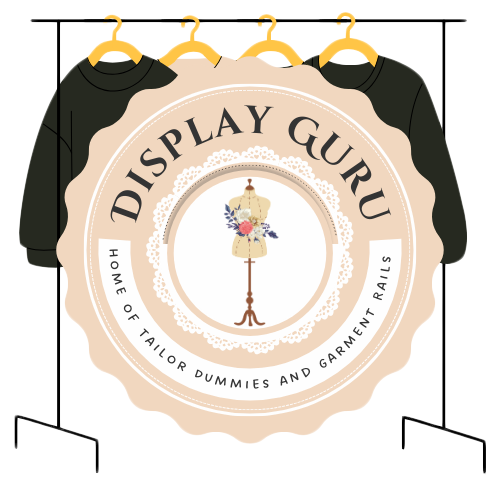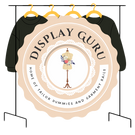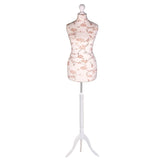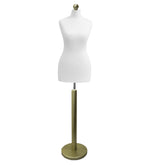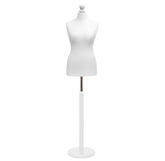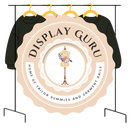What Is Fashion Illustration a Complete Guide
So, what exactly is fashion illustration? At its core, it's the art of telling a fashion story through drawing. It's less about creating a perfect, photorealistic copy of a garment and more about capturing its soul—the mood, the movement, and the overall feeling it's meant to evoke.
Think of it as the emotional heart of a design, brought to life on paper or a screen before a single stitch is sewn.
Unpacking the Art of Fashion Illustration
Fashion illustration is so much more than just sketching clothes. It's a specialised art form that acts as a bridge, connecting a designer's abstract vision to the final, tangible piece of clothing.
It stands in stark contrast to a technical "flat sketch," which is essentially a blueprint for a pattern maker. A flat sketch is all about precision and accuracy. A fashion illustration, on the other hand, is interpretive and emotional. Its job is to conjure up a feeling, to give the clothing a personality and a place in the world.
The illustrator’s real goal is to capture the fluid grace of a silk dress or the sharp, clean lines of a tailored blazer. To do this, they often use an elongated, dynamic figure known as a croquis, which helps to exaggerate and emphasise the garment's silhouette and drape. It’s all about selling an attitude, not just documenting a product.
The Core Components
At its heart, fashion illustration is a beautiful marriage of three key elements that must work in harmony.
- Artistic Expression: This is the illustrator's unique creative signature. It’s seen in their choice of line, their use of colour, and the overall composition, which all come together to create a specific mood—be it romantic, edgy, or wonderfully whimsical.
- Design Communication: The illustration has a job to do. It must present the garment clearly and compellingly, acting as a crucial communication tool between the designer, the buyer, and eventually, the customer.
- Technical Skill: This is the foundation. It demands a strong understanding of the human form, an ability to render different fabric textures convincingly, and mastery over the chosen tools, whether that’s traditional watercolours or digital software like Procreate or Adobe Illustrator.
The image below beautifully illustrates how these three pillars support the entire discipline.
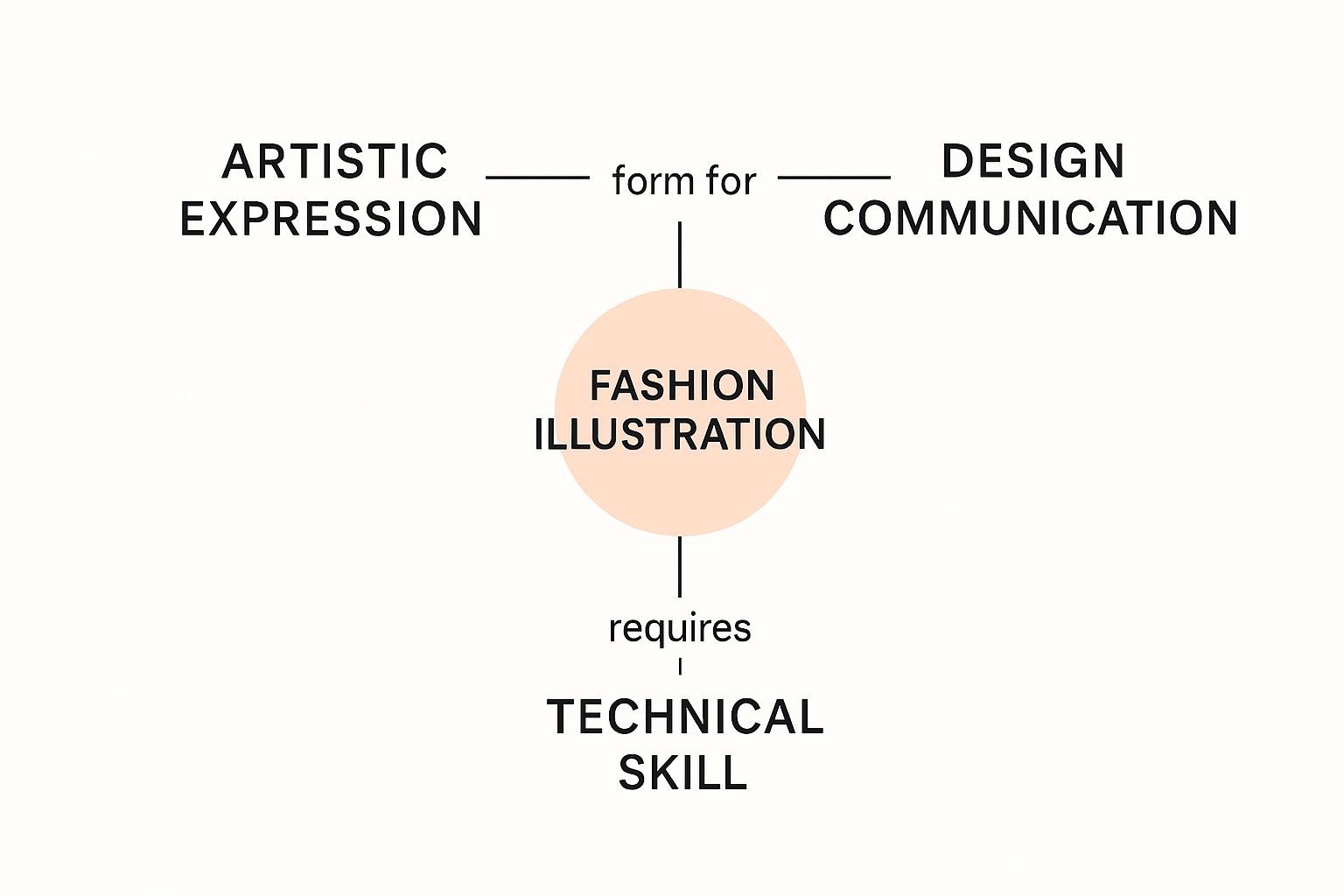
As you can see, a powerful illustration isn't just a piece of beautiful art; it's a functional communication tool built on a bedrock of solid technical ability.
To truly appreciate its unique role, it helps to see how fashion illustration compares to other, similar forms of drawing.
Fashion Illustration vs Technical Sketch vs Portraiture
| Attribute | Fashion Illustration | Technical Sketch (Flat) | Artistic Portraiture |
|---|---|---|---|
| Primary Purpose | To sell an idea or mood; evoke emotion and tell a story about a garment. | To provide a precise, technical blueprint for manufacturing and production. | To capture the likeness, personality, and essence of a specific person. |
| Style | Highly stylised, expressive, and dynamic. Figures are often elongated (croquis). | Flat, two-dimensional, and highly detailed with callouts for seams, stitches, etc. | Can range from hyper-realistic to abstract, but the focus is on the subject's face/form. |
| Focus | The garment's flow, silhouette, and the overall aesthetic. The model is a vehicle for the clothes. | Construction details, proportions, and technical specifications. The body is a neutral hanger. | The subject's face, expression, and character. The clothing is often secondary. |
This comparison makes it clear: while they all involve drawing, their goals are worlds apart. One tells a story, one gives instructions, and one captures a soul.
Key Takeaway: Fashion illustration isn't just a pretty picture; it's a strategic blend of art, design, and communication. Its primary function is to sell an idea and an aesthetic, breathing life into concepts long before they hit the runway or the shop floor.
The Evolution of Fashion Illustration Through History
The story of fashion illustration isn't just about drawing clothes; it's a fascinating look at how we've captured, communicated, and coveted style for centuries. Long before the camera became king, the illustrator's pen and brush were the only way to share the latest trends. Its origins can be traced all the way back to the 16th century, where detailed engravings and woodcuts recorded the elaborate dress of European royalty. These weren't art for art's sake—they were the very first form of fashion reportage for a small, elite circle.
These early images were more documentary than creative, but they paved the way for something much bigger. As printing technology improved, so did the art form itself. By the 19th century, beautiful hand-coloured fashion plates started appearing in magazines. Suddenly, these illustrations were the ultimate arbiters of taste, showing a growing middle class what to wear and how to wear it. They weren't just drawings of dresses; they were windows into an aspirational world.
The Golden Age of Influence
The true "golden age" for fashion illustration burst onto the scene in the early 20th century. This was when artists stopped simply recording what they saw and started interpreting it. Visionaries like Paul Iribe, Georges Barbier, and Erté used bold, stylised lines and dramatic poses to evoke the very soul of the Art Deco era. Their work wasn't just seen—it was felt. It graced the covers of iconic magazines like Gazette du Bon Ton, Vogue, and Harper's Bazaar, defining high fashion for an entire generation.
This period, from about 1909 to the late 1930s, was the absolute peak of the illustrator's influence. New colour printing techniques finally allowed the artists' vivid palettes to be reproduced faithfully, making the pages come alive. The tide turned sharply in 1939, however, when publications like Vogue UK began swapping illustrated covers for photographs, believing they offered a more modern realism. It was a change that would forever alter the landscape of fashion media. If you're curious, you can discover more about this significant shift in fashion communication and its history.
Adaptation and Reinvention
With the meteoric rise of photography, many predicted the death of fashion illustration. But they were wrong. The art form didn't just survive; it adapted, reinventing itself for a new era and finding powerful new roles away from the magazine cover.
Artists like René Gruau became legends for their post-war advertising campaigns. His bold, graphic work for brands like Dior wasn't just beautiful—it was often more memorable and emotionally resonant than a photograph. Gruau proved that illustration could capture a brand's unique essence in a way that couldn't be replicated.
This was a pivotal moment. Illustration was no longer just about depicting a garment; it became a strategic tool for building a brand's entire identity.
Its Enduring Relevance Today
Fast forward to today, and fashion illustration has firmly found its place again. In a world saturated with digital photography, its hand-drawn charm offers a refreshing, human touch. Designers rely on it during the crucial first stages of brainstorming a collection. Brands commission illustrators for one-of-a-kind marketing campaigns. And live illustrators have become a sought-after feature at exclusive fashion shows and events.
From a designer's initial concept sketches to artistic editorials and eye-catching social media content, fashion illustration continues to shape our perception of style. It has evolved from a simple method of recording fashion into a sophisticated and expressive tool for storytelling, proving that its artistic voice is as vital and influential as ever.
The Modern Fashion Illustrator's Toolkit
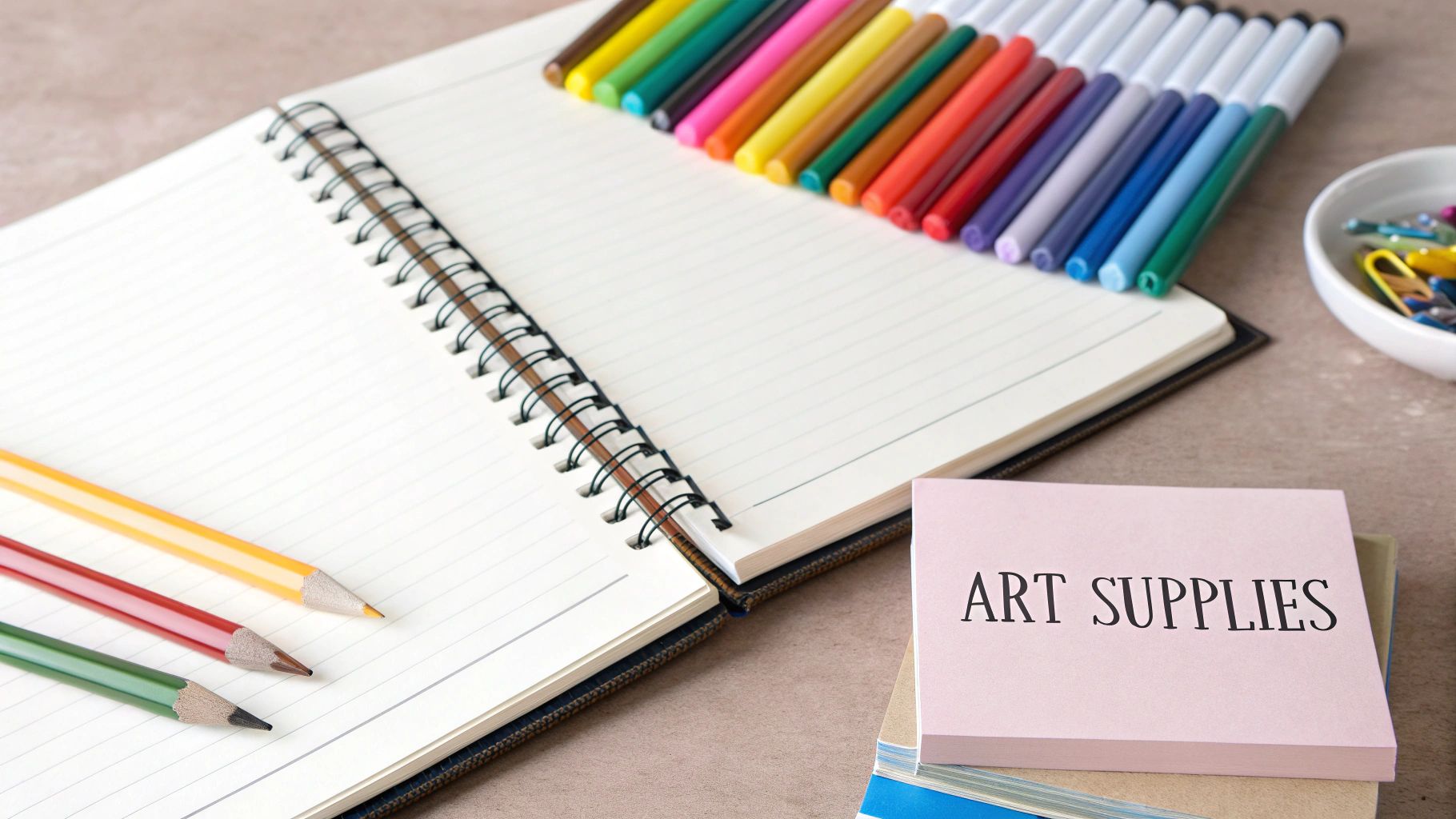
Every fashion illustrator, from seasoned professionals to curious beginners, has their own preferred set of tools for bringing ideas to life. The choice between traditional and digital mediums is more than just a practical one; it often shapes an artist’s entire style and workflow. Getting to know these tools is the first real step toward creating your own compelling fashion illustrations.
The traditional route offers a deeply tactile experience. It's all about the drag of a pencil across textured paper or the beautiful unpredictability of wet ink. These classic materials have been the bedrock of the craft for decades and still hold a special place in many artists' hearts.
Embracing Traditional Mediums
For anyone who loves a hands-on approach, the right materials are everything. They allow you to bring your creative vision to life with a certain authenticity and flair, where each tool leaves its own unique mark on the final piece.
A well-stocked traditional toolkit will usually feature:
- Pencils and Paper: It all begins here. Graphite pencils ranging from a hard 2H to a soft 4B give you a spectrum of tones for sketching. Good quality, heavyweight paper (at least 150gsm) is a must to handle inks and markers without them bleeding through.
- Fine-Line Pens: To create those sharp, definitive outlines over your initial sketches, you'll want some quality fine-liners. Brands like Micron or Copic are industry favourites for achieving a clean, professional finish.
- Markers: Alcohol-based markers, like the ever-popular Copics or Promarkers, are fantastic for rendering fabrics. Their real strength lies in how beautifully they blend, letting you create smooth gradients and rich, vibrant colours.
- Watercolours and Inks: If you're after a more fluid, expressive style, you can't go wrong with watercolours and Indian ink. They can produce everything from delicate washes of colour to dramatic, bold lines, giving an illustration a truly timeless, artistic feel.
The real magic of traditional illustration often lies in its happy accidents. A slight watercolour bleed or an energetic ink stroke can inject a personality and energy that’s difficult to plan or replicate digitally. It makes each piece truly one-of-a-kind.
The Power of the Digital Canvas
On the other hand, the digital toolkit opens up a world of flexibility and efficiency. It makes experimentation and corrections incredibly straightforward, which is a big reason why digital workflows have become an industry standard. A good graphics tablet, like one from Wacom, is pretty much essential; its pressure sensitivity is key to mimicking the feel of natural drawing.
At the heart of any digital process is the software. Adobe Illustrator is prized for creating clean, scalable vector lines, making it perfect for technical flats and commercial projects. In contrast, Procreate (for the iPad) has won over artists with its wonderfully intuitive interface and a massive library of brushes that do an amazing job of replicating natural media.
A crucial skill for digital illustrators is ensuring the colours on screen look just as good in print. This is why mastering color management in printing is so important for professional work. It guarantees that a client receives a piece that perfectly matches the vibrant artwork they approved on screen.
Of course, many illustrators choose not to pick a side. They often get the best of both worlds by sketching traditionally before scanning their work to add colour and finishing touches digitally.
Mastering Core Fashion Illustration Techniques

Once you’ve got your tools sorted, it’s time to get to the heart of the craft: the core skills that elevate a simple drawing into a compelling fashion illustration. These techniques are the language illustrators use to tell a garment’s story with both style and substance. It all begins with the human form, but perhaps not as you know it.
Fashion illustration isn’t about photorealism. Instead, we use a stylised figure called a croquis (French for “sketch”) to inject a dose of elegance and drama. This elongated form acts as the perfect canvas, allowing the clothes to take centre stage and look their absolute best.
Drawing the Iconic Fashion Figure
The industry-standard fashion croquis is built on the “9-heads” method. It’s a simple but effective technique where the head becomes the core unit of measurement. Using this, you construct a figure that stands about nine heads tall, a deliberate exaggeration compared to the average person’s seven or eight.
Most of this extra height is added to the legs, which gives the figure a taller, more graceful silhouette. The aim isn't anatomical correctness; it's about creating an aspirational frame that makes the clothes feel dynamic and desirable. Getting this proportion right is one of the first and most important milestones for any aspiring illustrator.
Bringing Fabrics to Life
A truly great illustration lets you feel the fabric just by looking at it. The real magic happens when an artist uses line, shade, and colour to render different textures, giving you an immediate sense of how a garment might move and feel against your skin.
To pull this off, illustrators have a whole toolkit of visual cues:
- Silk or Satin: Think long, fluid lines and sharp highlights. This combination perfectly captures its signature glossy sheen and the way it reflects light.
- Denim or Tweed: Here, you’d use shorter strokes, maybe some cross-hatching, and a slightly broken line to communicate that stiffer, woven texture.
- Fur or Fleece: This is all about building depth. Soft, layered stippling or fluffy, overlapping marks create a convincing sense of plushness.
- Chiffon or Organza: Less is more. Use light, almost transparent washes of colour and very delicate lines to suggest its sheer, airy quality.
Understanding how to draw these textures goes hand-in-hand with understanding how clothes are actually put together. In fact, many illustrators dive into various sewing techniques to get a better feel for how a fabric’s structure influences its drape and fold.
Key Insight: The best illustrators are fantastic observers. They spend time studying how fabric interacts with the body—the way it gathers at a waistline, pulls tight across the shoulders, or cascades in a full skirt. This attention to detail is what breathes life and authenticity into their work.
Capturing Movement and Energy
A static, rigid figure isn’t going to sell a fashion concept. The final, crucial ingredient is to infuse your drawing with a sense of movement and energy. This comes down to two things: the pose and the use of dynamic lines.
An expressive pose can tell a story all on its own. A figure with a hand placed confidently on the hip radiates attitude, while a model captured mid-stride evokes an effortless, on-the-go vibe. The classic contrapposto stance, where the body’s weight is shifted onto one leg, is a favourite for creating a relaxed yet elegant S-curve.
Equally important are the quick, energetic, gestural lines that define the flow of the pose and the garment. These confident strokes guide the viewer’s eye through the image and make the entire illustration feel alive. It's what turns a drawing of clothes into a vibrant, captivating piece of art.
The Role of Illustration in Today's Fashion Industry
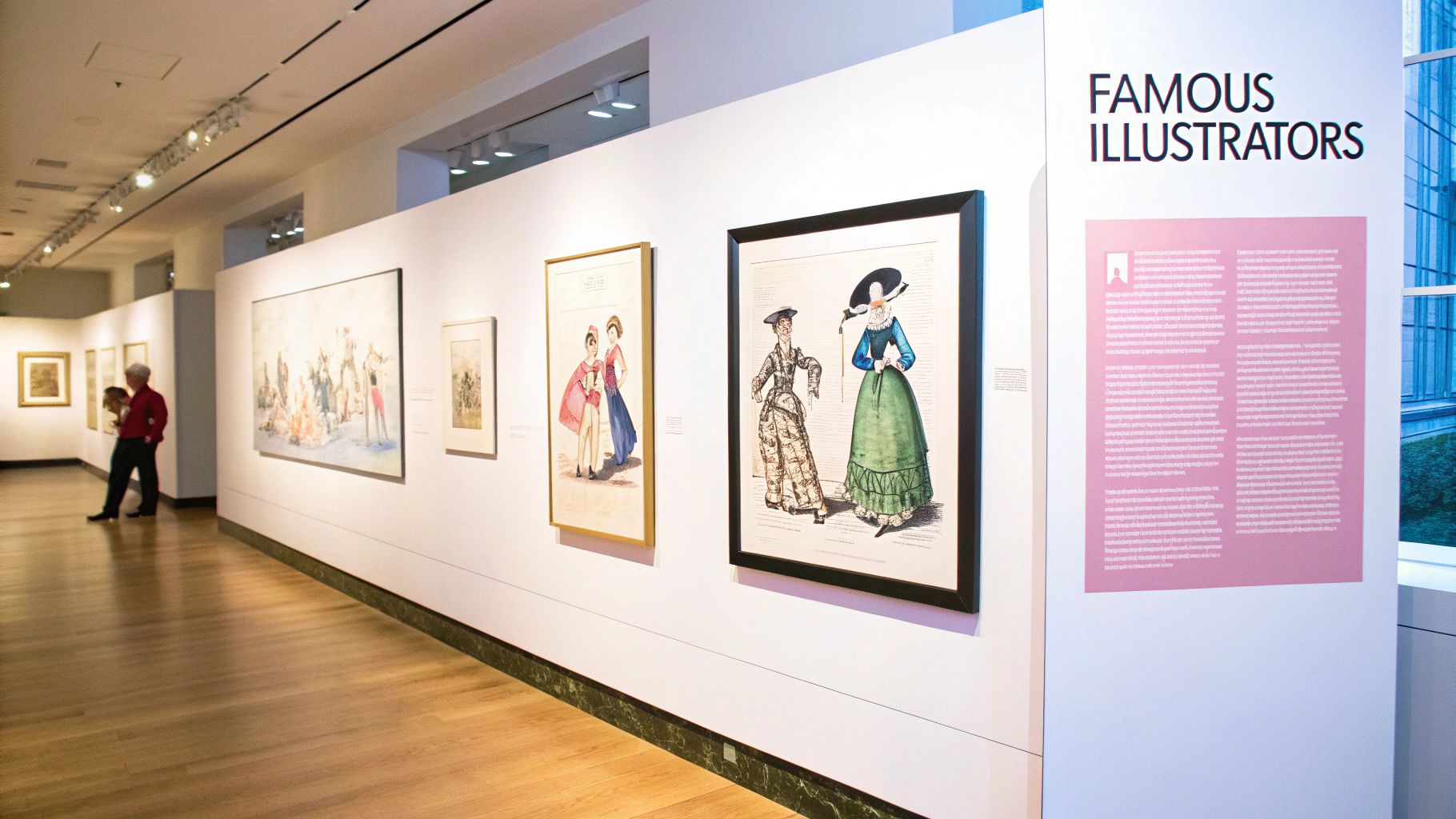
You might think fashion illustration is a charming relic, but it's arguably more vital now than ever. In an industry flooded with perfectly polished photography, the unique, hand-crafted feel of an illustration gives brands a powerful way to cut through the noise. Its role is incredibly varied, influencing everything from the first creative spark to the final marketing push.
At its core, illustration is the lifeblood of conceptualisation. Long before a single piece of fabric is cut, designers and illustrators work hand-in-hand to bring a collection to life on paper. These aren't just simple sketches; they are mood boards, capturing the attitude, spirit, and aesthetic of the garments. This process allows for rapid, fluid experimentation with silhouettes and styles without the time and expense of creating physical samples.
Historically, UK fashion houses relied on artists for this exact reason. Many brilliant designers weren't trained illustrators, so they would bring in specialists to create elegant, practical records of their collections. These often included fabric swatches to both inform and entice their clients. You can learn more about the historical business of fashion illustration and see just how deeply it's woven into the industry's past.
Beyond the Design Studio
The influence of fashion illustration reaches far beyond the initial design phase. It's now a formidable tool in modern marketing and brand storytelling, offering an artistic, often more soulful, alternative to standard product photos.
- Social Media Content: Brands commission illustrators to create distinctive posts for platforms like Instagram. An artistic rendering of a new handbag or dress can generate serious buzz and stand out in a sea of sameness.
- Live Event Illustration: It's become a signature touch for high-end brands to hire illustrators for product launches and fashion shows. These artists create quick, stylish portraits of guests, offering a memorable, personal, and highly shareable piece of the brand experience.
- Advertising and Editorials: In magazines and digital campaigns, an illustration can communicate a sense of luxury and exclusivity that photography sometimes struggles to match. It elevates a product showcase into a piece of collectible art.
Illustrations offer a human touch that really resonates with people. An artist's unique style can become synonymous with a brand's identity, forging a powerful emotional connection that goes far beyond simply showing off a product.
Merchandising and Retail
Illustration even has a place on the shop floor. Artistic interpretations of a collection can be used in lookbooks, on packaging, and as stunning backdrops for in-store displays. This helps to build a cohesive and immersive world for the customer to step into.
Knowing how to blend these artistic elements with commercial goals is a key part of modern brand presentation. For anyone interested in this side of the business, exploring visual merchandising guidelines offers fantastic insight into how art and commerce meet in a retail space.
By bridging the gap between artistic vision and commercial reality, fashion illustration continues to prove itself an indispensable asset for any modern fashion brand.
How to Build a Career in Fashion Illustration
So, you've got a passion for fashion and a talent for drawing. How do you turn that into a real, paying career? It takes more than just skill; it's about combining your artistic talent with a bit of business savvy and a whole lot of persistence. It's a tough industry, no doubt, but finding your own space within it is incredibly rewarding. The first step, and the most important one, is developing your personal style.
Your signature style is what makes your work instantly recognisable. It's your artistic fingerprint. Maybe it's the way you use bold, graphic lines, your love for soft watercolours, or the unique energy you give your figures. This doesn't happen overnight. It comes from endless experimentation and just drawing. A lot. Keep at it until you land on something that feels truly you.
Developing Your Professional Toolkit
With a style taking shape, your next focus should be your portfolio. Think of it as your professional calling card—it's the single most important tool you have. A strong portfolio showcases your best work and tells potential clients exactly who you are as an artist. For any illustrator starting out today, it's essential to build a compelling online portfolio that acts as your 24/7 gallery.
When putting your collection together, try to see it through a client's eyes. What would they need to see to hire you?
- Show Your Range: Include a mix of different things. Think character poses, close-up details of fabrics and textures, and maybe a few full-scale editorial illustrations that tell a story.
- Quality Over Quantity: This is key. Ten exceptional pieces will always be more powerful than thirty mediocre ones. Be ruthless in your curation.
- Presentation is Everything: A sloppy presentation can kill even the best work. Whether you have a physical portfolio book or a clean, sharp website, make sure it looks professional. For some brilliant ideas, take a look at these fashion design portfolio examples to see how the pros do it.
Finding Your Path: Formal Training vs. Self-Teaching
The age-old question: do you need a degree? The short answer is no, not always. But it can certainly give you a leg up. In the UK, fashion illustration has a long academic history. The establishment of a fashion drawing course at St Martin’s School of Art back in 1931, led by Muriel Pemberton, was a huge step in cementing it as a serious profession.
A formal education offers a structured path, giving you dedicated time to hone your craft, invaluable industry connections, and the discipline of working to deadlines. On the other hand, countless successful illustrators are entirely self-taught, learning their trade from online courses, workshops, and pure, focused practice.
Ultimately, your portfolio is what speaks for you, not a certificate on the wall.
Building a career is an active process. Use platforms like Instagram as a living, breathing portfolio to get your work seen. Connect with designers, art directors, and other creatives. Don't be afraid to put yourself out there and chase down opportunities. With a standout portfolio and a bit of grit, you can absolutely turn your art into a successful profession.
Common Questions About Fashion Illustration
As you start to get your head around the world of fashion illustration, you’ll probably find a few practical questions bubbling up. It’s a field where art and commerce meet, so it's only natural to wonder about things like raw talent, career paths, and what you can realistically earn. Getting these questions answered is often the first step to turning a spark of interest into a real pursuit.
One of the biggest hang-ups people have is whether you need to be an amazing artist, in the classic sense, to succeed. The short answer? Absolutely not. Fashion illustration isn't about creating a perfect, photorealistic copy. It's about communicating an idea, a mood, a feeling. Your unique style is far more valuable than technical perfection.
The real secret isn't some god-given talent; it's practice. Your artistic signature—the unique way you use lines, colour, and composition—is what will catch a client's eye and make your work memorable.
Career Distinctions and Earnings
People often get a bit fuzzy on the difference between a fashion illustrator and a fashion designer. Think of it like this: the designer is the architect, dreaming up the garment and figuring out how to construct it. The illustrator is the visual storyteller who brings that concept to life on the page, creating an evocative image that sells the dream, often for marketing or client presentations.
So, what about the money? For a freelance fashion illustrator in the UK, earnings can be all over the map. When you're just starting out, you might charge somewhere between £150–£300 for a single illustration. But once you've built a name for yourself and a strong, recognisable brand, that figure can jump into the thousands for a big commercial campaign. Live illustration at events is another fantastic way to earn, with day rates typically starting around £400 and going much higher for prestigious gigs.
As your skills grow, you'll realise just how important your workspace is. Having great lighting and a setup where you can find everything easily makes a world of difference. Looking into good sewing room organization can give you some brilliant, transferable ideas for setting up your own perfect creative studio.
Whether you are building a professional portfolio or getting your home studio just right, Display Guru has the essential tools you need. Explore our range of tailor's dummies, garment rails, and display forms at https://www.displayguru.co.uk.
